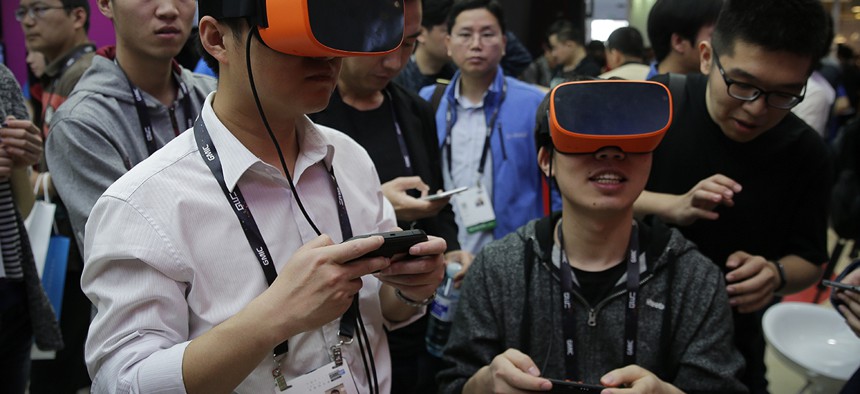What Possibilities Can Virtual Reality Bring Beyond the Gaming World?

Visitors wearing virtual reality devices play games at a display booth for Qualcomm at the 2016 Global Mobile Internet Conference (GMIC) in Beijing, Thursday, April 28, 2016. Andy Wong/AP
One real-world application is leveraging it as a tool to treat various mental problems like severe paranoia.
John Breeden II is an award-winning journalist and reviewer with over 20 years of experience covering technology and government. He is currently the CEO of the Tech Writers Bureau, a group that creates technological thought leadership content for organizations of all sizes. Twitter: @LabGuys.
Virtual reality is one of those technologies that has sat on the edge between reality and science fiction for decades, but is now finally going mainstream. And although this first modern generation of VR is beginning life mostly focused on games, don’t think that is where this technology will end up.
Being a huge nerd, my first real VR experiences go back a bit, to the Dactyl Nightmare arcade game. It was a stand-up unit, probably costing something like $100,000 at the time. You shot a really blocky-looking crossbow at an opponent in the neighboring pod, and also defended against an annoying pterodactyl (hence the name) that liked to swoop down from your blind side.
It was far from an immersive experience, and while that didn’t keep me from spending a small fortune mastering the game, its possible real-world applications were rather limiting.
In fact, VR mostly died for a while around that time. Computers were not yet powerful enough to drive truly immersive experiences, and the cost of the units that were produced were more than most vehicles.
Today, however, the world is a different place.
You can support an amazingly detailed virtual world almost indistinguishable from reality with technology under $1,000, sometimes less. The flagship product driving this virtual reality craze is the Oculus Rift, which can be pre-ordered now for an August release. It’s got deep pockets in development money, with the company, Oculus VR, being bought out by Facebook for $2 billion in 2014.
I used some of my connections in the videogame industry to get some playtime with the Oculus Rift, and specifically a climbing simulation called "The Climb." It’s completely insane. It doesn’t hurt I’m kind of afraid of heights, but I really thought I was going to fall several times trying to free-climb up some crazy mountains.
Even though only my eyes and ears were getting feedback, it was more than enough to trick my brain into thinking that I was really there because the graphics are so amazingly true-to-life, and all real-world visual and audio feedback was blocked out. My heart rate even spiked while I was playing.
Given my unease with heights, it makes sense "The Climb" was an intense experience for me. Although it was scary at first, eventually I found myself getting more comfortable with high up places. And that is the idea behind using virtual reality as a tool to treat various mental problems like severe paranoia, which is being studied at Oxford University.
According to the Oxford research team, about 2 percent of the population experience some level of paranoia. To compensate, sufferers often limit their social interaction with others, avoid eye contact and generally limit any intimate contact. This makes their condition worse and can lead to more serious problems like schizophrenia.
One possible treatment might be facing those fears in a virtual reality, which is now possible because of the leaps and bounds made recently by the technology. At Oxford, they gathered 30 people who felt uneasy about social situations and put them into virtual realities that mirrored what they feared. For example, they might have to stare into the eyes of a virtual person for a while, or ride a virtual subway car that keeps filling up with more and more people.
After a time in the VR, they began to get more comfortable with their surroundings. They were then taken out in public for real, and reported much less unease after conquering their fears in the VR. It was not unlike me and the climbing simulation, though I still had no desire to go up to the roof.
It’s not a complete cure yet by any means, and even the researchers don’t know how long the therapeutic benefits of a VR session would last, but it’s an interesting option that was not really available before now.
On the cybersecurity side, one of my contacts who asked not yet to be named, informed me their security company was working on a VR simulation for security information event management, or SIEM, personnel.
These are the folks who sit in command centers and watch security events being automatically reported across an enterprise. They work long hours, even through the night, and mostly just stare at screens. Fatigue tends to set in and that lowers their ability to make good decisions, or they may even miss important events.
My contact’s company, a major firm within cybersecurity, is working on a way to visualize all those alerts and events through a virtual reality interface which would make it almost seem like a giant video game.
The SIEM personnel might even eventually be able to take certain actions like wiping and restoring drives using the VR interface in a way that is interesting and almost game-like.
The goal would be to hold SIEM workers' attention for an entire shift and keep them operating at peak efficiency. It might even make their important jobs fun.
If I get permission, I will dive more into that product in the future. But it, what is going on at Oxford, and even that climbing simulation are only the tip of the iceberg with VR. It’s a technology breaking both the technology and price barriers, and which should soon lead to new and exciting endeavors that would not have been possible even a couple years ago.






